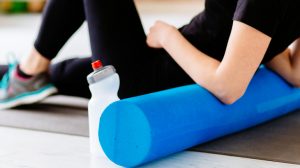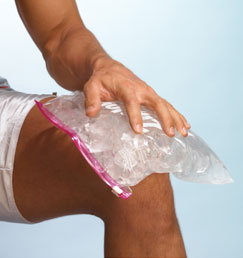An Alternative Approach to Stretching
Clinicians, athletes and rehabilitation specialists advocate stretching as a means for injury prevention and treatment. The primary purpose of any stretching technique is to enhance pliability and flexibility in the soft tissues. It is also routinely incorporated with massage in the treatment of pain and injury conditions. There are many different stretching techniques, which all fall into one of three primary categories: static, ballistic or active-assisted stretching.
Static stretching is the most common. In static stretching, you bring the target muscle into a lengthened position and hold it there until you have achieved the desired stretch. The ideal length of time to hold a static stretch is debated in the literature and the results appear inconclusive. Somewhere around 15 to 20 seconds is a common time frame that achieves good clinical results.
Ballistic stretching is used most commonly in the athletic environment. During a ballistic stretch, you bob or bounce into a stretch to encourage tissue elongation in the muscle. Ballistic stretching works by using the momentum of the moving limb to extend past the initial limitation of range of motion. Many people oppose the use of ballistic stretching because the rapid elongation of muscle tissue in the bouncing motion can activate the stretch reflex, which would be counterproductive to stretching.
In active-assisted stretching, the client actively engages a specific muscle contraction prior to, or during, the stretching procedure. There is a variety of active-assisted techniques and they go by different names such as PNF, muscle-energy technique, active isolated stretching or facilitated stretching. There are slight variations in each of these methods, but they are all based on the neurological principles of post-isometric relaxation (PIR) and reciprocal inhibition. Experiments that compare active-assisted methods with static or ballistic stretching show the greatest range of motion gains with active-assisted methods.
Immediately following an isometric contraction, there is an increased degree of relaxation in that same muscle. This immediate reduction in neurological activity is called the post-isometric relaxation (PIR). The methods of active-assisted stretching use the window of reduced neurological activity during the PIR to engage a stretch of the target muscle after it has isometrically contracted. Stretching during the PIR is more effective than stretching without the prior isometric contraction.
The other neurological principle that is of important in active-assisted stretching methods is reciprocal inhibition. When an agonist (target) muscle contracts, there is a neurological inhibition of its antagonist (opposite) muscle. The reduction in neurological activity in the antagonist muscle is called reciprocal inhibition. Because reciprocal inhibition decreases neurological activity in muscles opposite the ones being contracted, it is helpful to use during stretching procedures. Stretching of the target muscle is enhanced when its opposite muscle is contracted at the same time (Fig. 1).
The various techniques of active-assisted stretching advocate different lengths of time to hold the isometric contraction prior to stretch. Initial research has indicated that a relatively short period of nonmaximal isometric contraction (about 3 seconds) seems most effective for holding the contraction prior to stretch.1 These methods also vary in the length of time that the stretch is held. A study investigating active-assisted stretching compared stretch duration times of 3 seconds and 30 seconds and found no significant difference in the outcomes between the two time periods.2 More research is needed to determine the ideal stretching method(s). It may turn out that the optimum stretching method depends on the situation in which it is being used.
Effective Stretching Procedures
 Hamstring stretching with reciprocal inhibition. During this hamstring stretch the practitioner will engage the hip flexors concentrically by attempting to further flex the hip. Engaging the hip flexors causes reciprocal inhibition of the hamstring group (the target muscle to be stretched). Each of the stretching procedures mentioned above must take into account the biomechanical and neurological properties of the myofascial unit. Therefore, all stretching procedures engage two primary components: the physical stretch of muscle and connective tissue (mechanical effects) as well as the reduction in neurological resistance to stretch (neuromuscular effects).
Hamstring stretching with reciprocal inhibition. During this hamstring stretch the practitioner will engage the hip flexors concentrically by attempting to further flex the hip. Engaging the hip flexors causes reciprocal inhibition of the hamstring group (the target muscle to be stretched). Each of the stretching procedures mentioned above must take into account the biomechanical and neurological properties of the myofascial unit. Therefore, all stretching procedures engage two primary components: the physical stretch of muscle and connective tissue (mechanical effects) as well as the reduction in neurological resistance to stretch (neuromuscular effects).
Fascia is interwoven throughout muscles in an extensive network. It has viscous properties that respond better to slow, sustained tensile loads and resist rapid elongation.3 The process of connective tissue gradually lengthening when a sustained stretch is applied to it is called creep. The extensive fascial network running through all muscles suggests greater benefit for longer-duration stretching methods to take advantage of connective-tissue creep.
The neurological resistance to stretch is primarily governed by a specialized proprioceptor called the muscle spindle. It is responsive to both the rate of muscle stretching and the amount of stretch in the tissue. If the muscle is stretched too fast or too far, the muscle spindle sends signals to the central nervous system and an immediate muscle contraction is engaged to prevent overstretching. This immediate muscle contraction is called the myotatic (or stretch) reflex. Stretching procedures attempt to minimize any recruitment of the stretch reflex.
An Alternative Method
 Enhancing a hamstring stretch. The practitioner uses one hand to hold the limb in the stretched position and the other hand applies the fascial elongation technique to the target muscle group (hamstrings).
Enhancing a hamstring stretch. The practitioner uses one hand to hold the limb in the stretched position and the other hand applies the fascial elongation technique to the target muscle group (hamstrings).
(Photo courtesy of Bob McAtee) Manual-therapy practitioners have been excited by recent research studies enhancing our understanding of the physiological properties of fascia. We have recently learned that fascia contains contractile cells and is capable of releasing its contraction and further elongating when a prolonged tensile load is applied to it.4 Armed with this new understanding, we can use the physiological properties of fascia to enhance stretching procedures. Combining active-assisted stretching methods with fascial-elongation methods would address both the neuromuscular and connective-tissue components of the stretching process.
Consider hamstring stretching as an example of how this works. Engage the hamstrings in a short 3-second nonmaximal contraction. Release the contraction and bring the hamstrings into a stretched position (Fig. 2). Have the individual attempt to further stretch the hamstrings by attempting to flex the hip as far as possible (as they did in Fig. 1). This movement engages the reciprocal inhibition process and encourages further lengthening. While this position is held, apply a myofascial-stretch technique (with the hand or back side of the fist) to the hamstrings and hold it for about 30 to 60 seconds. Holding the myofascial stretch encourages relaxation of the fascial contractile cells and enhances connective tissue creep.
Both the neuromuscular and connective-tissue components of the stretch are emphasized by combining these myofascial and active-assisted stretching techniques. I have found this stretching method helpful with a number of chronically tight muscles. In the future, it will be valuable to perform comparative studies with this and other stretching techniques to find out which ones are most effective under various clinical circumstances.
References
- Sharman MJ, Cresswell AG, Riek S. Proprioceptive neuromuscular facilitation stretching: mechanisms and clinical implications. Sports Med 2006;36(11):929-39.
- Smith M, Fryer G. A comparison of two muscle energy techniques for increasing flexibility of the hamstring muscle group. J Bodyw Mov Ther Oct 2008;12(4):312-7.
- Taylor DC, Dalton JD, Jr., Seaber AV, Garrett WE, Jr. Viscoelastic properties of muscle-tendon units. The biomechanical effects of stretching. Am J Sports Med May-Jun 1990;18(3):300-9.
- Schleip R. Fascial plasticity: a new neurobiological explanation. J Bodyw Mov Ther 2003;7(1):11-9.
Ready to #feelbetter?
You're just a click away from a wicked good massage!
-

60 Minute Massage Gift Card
$170.00 Add to cart -

90 Minute Massage Gift Card
$255.00 Add to cart -

Mini Aer Small Room Air Purifier
$149.00 Add to cart -
Sale!

Thera-Pearl Sports Pack/Hot Cold
Original price was: $14.99.$12.99Current price is: $12.99. Add to cart -

3 Somadome Sessions Gift Card
$135.00 Add to cart -

20 Minute Somadome Gift Card
$45.00 Add to cart -
Sale!

TheraBand® Stretch Strap
Original price was: $19.99.$14.99Current price is: $14.99. Add to cart -

TheraBand CLX Connective Loop
$14.99 Select options
May Flowers-Life Hack
April Showers Bring 5 Flower Hacks What do you get when you combine soda, vodka, apple cider vinegar, hair spray & bleach? Some incredible ways to preserve your flowers this season. Sure, April showers bring May flowers, but mother nature went a tad over board with it this April. So how well are you prepared…
Read More#FeelBetterBoston Recap
#FeelBetterBoston Recap The inaugural #FeelBetterBoston Massage & Community Wellness event over Marathon weekend left people with a smile on their face and genuine appreciation for all that was provided. We knew this being the first time we held such an event that we would be competing with the likes of the infamous BAA Expo and other…
Read MoreHow Do You Roll??
How Do You Roll?? Are Foam Rolling Advocates Stretching the Truth? Foam rolling is one of the most common means of self-care for so many people. It has been thought to provide many benefits such as enhanced performance, improved flexibility and speed, pain reduction and muscle recovery. Often it is referred to as a self-massage technique,…
Read MoreOn the Mend
On the Mend As we quickly approach the holy grail of running events, the Boston Marathon, we start to see a rise in our battered and beaten road warriors. Overuse conditions from months of increased training, acute injuries from falls on slippery roads and chronic aches and pains, all result in the patient surrendering to…
Read MoreLife Hack: Watch the SB LIII on TV, but LISTEN on the Radio
Life Hack: Watch the SB LIII on TV, but LISTEN on the Radio So, our beloved Pats are back in the big game again. I’m not going to relay stats and numbers that drive home the dynasty known as the New England Patriots. We are all aware of them. However, if you want to enjoy…
Read MoreCortisone Injections: Yay or Ney?
Cortisone Injections: Yay or Ney? As massage therapists, we often see patients who have been struggling to find an answer for a particular pain problem. Some of these cases are acute (sudden onset) where others may be chronic (reoccurring over a long period of time). It is not uncommon to have a patient ask us…
Read MoreChiropractic Care at The Boston Bodyworker
Chiropractic Care at The Boston Bodyworker We are excited to announce the arrival of Dr. Jean Kelly of Momentum Healthcare to our office. Dr. Kelly has been practicing in our building for the past 10 years and has been a friend to The Boston Bodyworker for almost 20 years. We are honored to have her…
Read MoreSpine Health: Don’t Ignore It!
Spine Health: Don’t Ignore It! The new year always provides us with the feeling of having a clean slate. Let’s face it, most of us don’t take very good care of our spines. 2019 can be the year that your resolutions come true. This lack of care can lead to physical discomfort and make us…
Read MoreLife Hack: Drink Tea
Life Hack: Drink Tea With the rainiest and most dreary Fall in recent time behind us and winter now in full swing, the need for us to provide optimal care for ourselves is high. Despite American’s love affair with coffee, tea is really the more versatile of the beverages. Most of us reach for a…
Read MoreLife Hack: Forward Head Posture
Life Hack: Forward Head Posture How many times in the course of a day do you roll your shoulders and neck around to alleviate “the spot” in between your shoulder blades. There are several reasons for the discomfort you are experiencing, but one way to resolve this is to do what is known as a…
Read More



